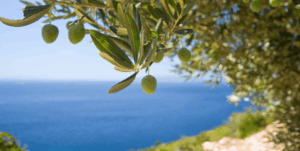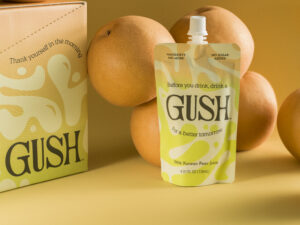Olive oil has long been celebrated as a cornerstone of the Mediterranean diet – a golden elixir praised for its heart-protective polyphenols, anti-inflammatory compounds, and antioxidant benefits. But beneath the health halo lies a dark reality: a massive amount of the olive oil sold in stores is fake, adulterated, or mislabeled.
This isn’t some fringe conspiracy. Food fraud experts, investigative journalists, and even Interpol have confirmed it: olive oil is one of the most corrupt, manipulated products in the global food system.
So, how did one of the healthiest foods become one of the most untrustworthy? And what can you do to protect yourself and spot mislabeled olive oil?
The Scope of the Scam: What Olive Oil Fraud Looks Like
At the heart of the problem is economic incentive. Real extra virgin olive oil (EVOO) is expensive to produce. It requires quality olives, careful harvesting, proper milling, and clean bottling. But to the untrained eye – and palate – there’s virtually no way to tell whether you’re buying authentic EVOO or something much cheaper.
Cutting With Cheaper Oils
One of the most common scams involves diluting genuine olive oil with low-cost oils like:
- Soybean oil
- Corn oil
- Canola oil
- Sunflower oil
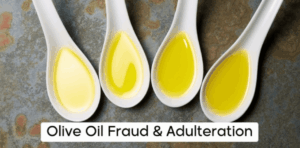
These refined seed oils are neutral in flavor and appearance, making them ideal for deception. In many cases, the final product still smells and tastes like olive oil, but it’s a far cry from the real thing.
Mislabeling Grades
“Extra virgin” is the highest quality grade of olive oil, indicating it was mechanically cold-pressed without chemical treatment and has low acidity. However, studies have shown that up to 60–80% of oils labeled “extra virgin” on supermarket shelves fail to meet that standard.
Falsifying Origins
Some producers claim their oil is from Italy, Greece, or Spain to command a higher price, even if it was produced elsewhere. In reality, many so-called “Italian” olive oils are sourced from Tunisia, Turkey, or Morocco and merely bottled in Italy.
Misleading Phrases
Terms like “cold-pressed,” “pure,” and “light” often mean nothing or worse. For example:
- “Pure” olive oil usually means it has been refined – stripped of flavor and nutrients – then mixed with a small amount of virgin oil.
- “Light” olive oil isn’t healthier or lower in calories – it’s just more processed and less flavorful.
- “Cold-pressed” is often thrown on labels even when mechanical processing involves heat.
Why Olive Oil Fraud Is So Widespread
The olive oil industry is a fraudster’s dream: high demand, high margins, low regulation.
Profit Margins
EVOO fetches a premium price. Cutting it with cheap oils allows producers and criminals alike to double or triple profits.
Lack of Oversight
In the U.S., the FDA does not rigorously test olive oil imports because it’s supposedly not a safety issue. International regulations vary widely, and enforcement is often lax. Fraudulent producers can operate for years before getting caught – if ever.
Organized Crime Involvement
In Italy, for example, mafia organizations have been caught infiltrating olive oil production chains—running fake mills, relabeling counterfeit blends, and selling them globally. According to Tom Mueller, author of Extra Virginity: The Sublime and Scandalous World of Olive Oil, olive oil is “more lucrative than cocaine for some criminal networks.”
production chains—running fake mills, relabeling counterfeit blends, and selling them globally. According to Tom Mueller, author of Extra Virginity: The Sublime and Scandalous World of Olive Oil, olive oil is “more lucrative than cocaine for some criminal networks.”
Consumer Ignorance
Most people can’t detect the difference between true EVOO and adulterated oil. This lack of consumer knowledge allows fraud to persist in plain sight.
Health Implications: When Olive Oil Isn’t What It Claims
People reach for olive oil because it’s seen as a healthy fat – a source of monounsaturated fatty acids, antioxidants, and polyphenols. Real EVOO can:
- Reduce inflammation
- Improve cholesterol ratios
- Protect against heart disease
- Support cognitive function
But when that bottle has been cut with refined seed oils, the health benefits vanish. In fact, the result is often harmful.
Why Seed Oils Are a Problem
- They’re high in omega-6 fatty acids, which can throw off your body’s natural omega-3 to omega-6 ratio and increase systemic inflammation.
- Most are chemically extracted with solvents like hexane and deodorized to mask rancidity.
- Overconsumption of seed oils has been linked to metabolic dysfunction, oxidative stress, and even infertility.
Regulation: A Toothless System
Despite growing awareness of olive oil fraud, enforcement has been sluggish. Here’s why:
U.S. Regulations Are Outdated
The USDA created a voluntary olive oil grading system in 2010, but few producers actually adhere to it. Meanwhile, the FDA doesn’t require testing or verification for olive oil imports.
International Bodies Lack Teeth
The International Olive Council (IOC) sets global standards, but they’re not enforceable. Countries like Australia and Chile have adopted stricter standards, but these are exceptions, not the rule.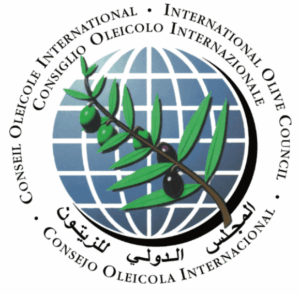
Industry Lobbying
The North American Olive Oil Association (NAOOA), which includes major global brands, often resists tighter regulations and transparency measures, arguing they’re burdensome or unnecessary.
How to Buy Real Olive Oil: A Consumer’s Survival Guide
Despite the corruption, you can find legitimate olive oil – if you know what to look for. Here’s your quick guide:
Look for a Harvest Date
Always check for a harvest date on the label. Olive oil is best consumed within 18-24 months of harvest. No date? Expired or close to it? Skip it.
Avoid Clear Bottles
Light degrades olive oil quality. Opt for dark glass bottles, tins, or opaque containers.
Go for Single-Origin Oils
Blended oils from multiple countries are more likely to be adulterated. Choose oils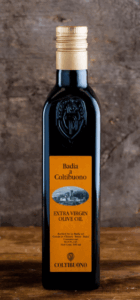 from one region or estate.
from one region or estate.
Check for Certifications
Look for third-party seals like:
Taste Test When Possible
Real EVOO should have a peppery bite, a bit of bitterness, and a fresh, grassy aroma. If it’s flavorless or greasy, it’s probably fake or old.
Buy From Trusted Producers
Farmers markets, reputable specialty stores, and small-batch producers are usually safer bets than mass-market brands. Some online retailers now offer lab-tested oils with full transparency.
The Good News: Scientists Have Developed Ways of Testing EVOO for Authenticity
SPR-Enhanced Ellipsometry for Detecting Adulteration
A 2024 study published in Food Analytical Methods introduced a novel technique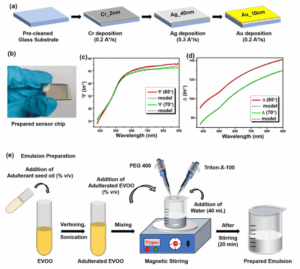 using Surface Plasmon Resonance-enhanced ellipsometry (SPRE) to detect adulteration in extra virgin olive oil (EVOO). This method effectively identified blends of EVOO with other edible oils, offering a sensitive approach to ensure product authenticity.
using Surface Plasmon Resonance-enhanced ellipsometry (SPRE) to detect adulteration in extra virgin olive oil (EVOO). This method effectively identified blends of EVOO with other edible oils, offering a sensitive approach to ensure product authenticity.
Mass Spectrometry-Based Authentication
Recent research utilized mass spectrometry (MS) to assess the authenticity and purity of virgin olive oil. The study highlighted the importance of selecting appropriate olive oil components for analysis to obtain relevant information on authenticity.
NMR Spectroscopy for Quality Assessment
A study explored the use of Nuclear Magnetic Resonance (NMR) spectroscopy to evaluate the quality and authenticity of virgin olive oil. This method provided insights into the oil’s composition, aiding in the detection of adulteration and assessment of quality.
Final Thoughts: Choose Consciously, Not Blindly
The olive oil scam isn’t just about food fraud – it’s a lesson in conscious consumerism. Even so-called “healthy” foods aren’t immune to corruption when profits take priority over transparency. But knowledge is power
By learning how to identify authentic oils and support ethical producers, you take a stand not only for your health but for food integrity itself.
So the next time you drizzle olive oil over your salad or sauté your veggies, ask yourself: Do I know what’s in this bottle? Is it authentic? Because when it comes to olive oil, purity is everything. Don’t waste your time, money, or health on fake EVOO.
